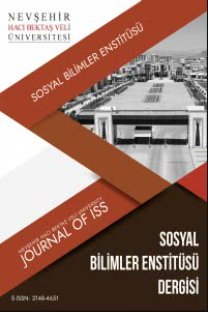TİCARET SAVAŞLARI VE DIŞ TİCARET
Ticaret Savaşları, Dış Ticaret, Sanayi Devrimi
TRADE WARS AND FOREIGN TRADE
Trade Wars, Foreign Trade, Industrial Revolution,
___
- Barrett, W. (1990). World bullion flows, 1450–1800. J. Tracy (Ed.), In The Rise of Merchant Empires: Long Distance Trade in the Early Modern World 1350–1750 (p. 1462). Cambridge University Press.
- Bekaroğlu, E. (2022). Antroposen: küresel değişimin politiği. DTCF Dergisi 62.2(2022): 1130-1149.
- Bernhofen, D. M., & Brown, J.C. (2004). A direct test of the theory of comparative advantage: the case of Japan. Journal of Political Economy 112: 48-67.
- Canıtez, M. (2011). Uluslararası pazarlamada lojistik ve uygulamalar. Gazi Kitabevi.
- Crafts, N. F. R., & Harley, C.K. (1992). Output growth and the British Industrial Revolution: a restatement of the Crafts–Harley view. Economic History Review 44:703–730.
- Cuenca Esteban, J. (2004). Comparative patterns of colonial trade: Britain and its rivals. L. Prados de la Escosura (Ed.), In Exceptionalism and Industrialisation: Britain and Its European Rivals, 1688– 1815). Cambridge University Press.
- Çaylı, Ş. & Babahanoğlu, V. (2020). ABD'nin küresel hegemonik üstünlüğünde ticaret savaşlarının araçsallaştırılması. Uluslararası Kültürel ve Sosyal Araştırmalar Dergisi (UKSAD), 6 (1), Yaz, s. 342-355.
- Çetin, A. (2004). Memluklar devrinde karimi tüccarları. Tarih Araştırmaları Dergisi, Cilt 23, Sayı 35, 2004, 71-87.
- Davis, R. (1962). English foreign trade 1700–1774. Economic History Review 15: 285-303. Davos'ta ana gündem gıda ve enerji krizi (2021). 16 Ocak 2023 tarihinde https://www.ekonomim.com/kuresel-ekonomi/davosta-ana-gundem-gida-ve-enerji-krizi-haberi-658297 adresinden alındı.
- Ferrier, R. (1986). Trade from the mid-14th century to the end of the Safavid period. P. Jackson and L. Lockhart (Ed.), In The Cambridge History of Iran, volume 6 (p. 486). The Timuridand Safavid Periods. Cambridge University Press.
- Findlay, R. & O’Rourke, K.H. (2007). Power and plenty: trade, war and the world economy in the second millennium. Princeton University Press.
- Görçün, Ö.F. (2020). Dördüncü endüstri devrimi endüstri 4.0. Beta Yayıncılık.
- Haider, N. (2002). Global networks of exchange, the India trade, and the mercantile economy of Safavid Iran. I. Habib (Ed.), In A Shared Heritage: The Growth of Civilization in India and Iran (p. 197). New Delhi: Aligarh Historians Society, Tulika Books.
- Hugill, P. J. (1993). World Trade since 1431. Baltimore, MD: Johns Hopkins University Press.
- Hummels, D. (1999). Have international transportation costs declined? Mimeo, University of Chicago.
- Inalcik, H. (1994). The Ottoman state: economy and society 1300–1600. H. Inalcik and D. Quataert (Ed.), In An Economic and Social History of the Ottoman Empire 1300–1914 (p. 227). Cambridge University Press.
- Mazumdar, S. (1998). Sugar and society in China: Peasants, technology and the world market. Harvard University Press.
- Mitchell, B. R. (1992). International historical statistics: Europe 1750–1988, 3rd edn. New York: Stockton Press.
- Naquin, S., & Rawski E.S. (1987). Chinese Society in the Eighteenth Century. Yale University Press.
- Seeley, J. R. (1971). The Expansion of England. University of Chicago Press.
- Seyidoğlu, H. (2020). Uluslararası iktisat. Güzem Can Yayınları.
- Solmaz, S, & Saygılı M.S. (2008). Konteynerin tarihçesi ve koneyner gemilerinin gelişimleri. Murat Erdal (Ed.), Konteyner Deniz ve Liman İşletmeciliği içinde, 3-18. Beta Yayınevi.
- Ünver, M. Sömürgecilik tarihi [PDF belgesi]. 12 Ocak 2023 tarihinde www.clouds.com.tr/web/uploads/dosya/ 285450.pdf adresinden erişildi.
- Yayın Aralığı: 4
- Başlangıç: 2011
- Yayıncı: Nevşehir Hacı Bektaş Veli Üniversitesi
UZAKTAN EĞİTİM SÜRECİNDE KARŞILAŞILAN SORUNLARA İLİŞKİN ÖĞRETMEN GÖRÜŞLERİ
Ender KAZAK, Hasan Hüseyin KARAAHMETOĞLU
Bilgen ÖZCAN COŞKUNSOY, Bahar GÜDEK, Valeriya ÖZKAN
BİZANS KAPADOKYASI’NDA ZİRAİ FAALİYETLER: YAZILI KAYNAKLAR IŞIĞINDA ARKEOLOJİK KANITLARIN OKUNMASI
Hilal KESER, Mehmet Hayri SARI
ÜCRET YÖNETİMİ BAĞLAMINDA ÖĞRETMEN MAAŞLARININ İNCELENMESİ
NEŞET ERTAŞ TÜRKÜLERİNDE SÖZ VARLIĞI
Tuğrul Gökmen ŞAHİN, Bedrettin KAYHAN
SINIF ÖĞRETMENLERİNİN OTANTİK LİDERLİK ÖZELLİKLERİ
Bengü ÖZDEN GÜLDAĞLI, Sibel GÜVEN
YARATICI SINIFIN (AR-GE ÇALIŞANLARININ) ÇALIŞMA HAYATLARINA İLİŞKİN DUYGULARI: STRES, KORKU/KAYGI
